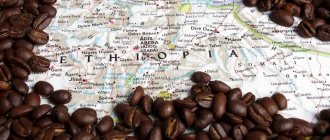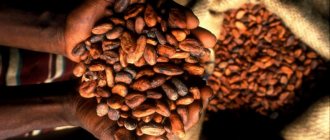Useful and harmful qualities of caffeine
If you drink in small quantities, it can have a positive effect on the human body. Caffeine in small doses increases physical and mental activity and improves mood. People involved in intellectual work, if they drink two cups a day, notice that they cope with tasks faster than their colleagues who do not drink this invigorating drink. American scientists have proven that caffeine is an excellent stimulator of neural activity, but it should not be abused frequently. Natural alkaloid (caffeine) can negatively affect health, especially for people suffering from gastritis, cardiovascular diseases, insomnia, and nervousness.
Caffeine is found in plants such as the coffee tree, tea, cocoa, mate, guarana, cola and some others.
Optimal caffeine levels
How much caffeine is in a teaspoon of coffee
Caffeine is found not only in coffee, it is also present in tea, cocoa, Coca-Cola, and chocolate.
However, its greatest concentration is still concentrated in coffee.
Interestingly, different varieties contain different amounts of trimethylxanthine.
Thus, in the Robusta variety its concentration reaches 2.5%, and in the Arabica variety – 1.2%.
How much caffeine is in different varieties
Coffee is like grapes - its taste depends on the composition of the soil in which it grew, climate, and growing conditions. The same variety can change its taste and aroma depending on the degree of roasting and grinding. Today, the Robusta coffee variety is the leader in terms of high caffeine content. Alkaloid levels reach 2.2%. If we compare it with Arabica, it contains only 1.2%.
Caffeine is one of the most widely and regularly consumed natural biologically active compounds, known since ancient times.
The level of caffeine cannot be determined by the taste, aroma, or bitterness of the drink. It is not possible to determine the amount of natural alkaloid using the senses. If the beans have been heavily roasted, the strength of the drink will be lower. This is due to the chemical process involved in roasting the beans. When heated during roasting of beans, the molecules of the stimulating substance are destroyed.
Roast Methods and Caffeine: Dark vs. Light
Many coffee lovers and enthusiasts find that the amount of caffeine in their favorite mug depends on the type of roast they're brewing. It's true, but it's not as important as you think.
Dark roast
You might assume that darker roasts have more caffeine. And it makes sense on the surface.
We often say that dark roasts are "stronger" because of the bold flavor that darker roasts provide. They tend to be more intense, while lighter roasts tend to have floral or citrusy undertones. For many, this means “weaker” coffee.
These differences are purely a matter of taste. Dark roasts do not contain more caffeine than light roasts. If anything, there is less of it.
Light roast
How can a lighter roast contain more caffeine?
Coffee lovers with a little more knowledge about beans assume that the roasting process burns off some of the caffeine. Because dark blends are roasted longer, they claim, they lose more caffeine content.
That's almost right. Roasting itself actually removes very little caffeine because it is a very stable compound.
What happens instead is that the beans expand as they fry. Beans roasted for a longer time lose more water, becoming larger and less dense. So if you measure your coffee by volume, a lighter roast will contain more beans.
More beans mean more caffeine. The difference is minimal though. And if you measure your coffee by weight, there is no difference in the amount of caffeine in light and dark roasted coffee.
So when choosing your roasts, decide on flavor preferences rather than the amount of caffeine they may have. The difference is not enough to warrant change.
Rating by amount of caffeine
The most caffeinated beans grow in certain geographic locations. The well-known Arabica variety, brought from South America, a drink rich in taste and aromatic qualities, may not be at all strong. Brazilian and Colombian varieties lead the world market. The drink from these countries has medium strength and a mild taste. Beans from the Middle East and Africa have the highest levels of caffeine.
Caffeine gets its name from one of its main sources - coffee beans.
Robusta contains the most caffeine
It has a second name - Congolese. It contains the highest amount of caffeine from 2 to 4%. The taste of this drink is rich and the aroma is pronounced. It is consumed in a mixture with other varieties due to the presence of bitterness, but this drink is also popular in its pure form. Robusta translates to “strong.” And this name fully corresponds to it - it can germinate where Arabica does not take root.
Robusta is the default commercial coffee
When this variety grows, its leaves are large and its flowers have a white-pinkish color. The grains ripen up to 12 months. They are larger in size than Arabica beans by 5-7 millimeters. Those who have tasted it note the bitterness in the taste of the drink. However, there are connoisseurs of this coffee - tart, bitter and even spicy.
Monsoon Malabar
One of the varieties of Arabica is unlike any other variety. The coffee does not have bright richness, sourness or fruity notes. Despite its “smooth” taste, Malabar is memorable, with its own twist. This coffee taste is often found in the East in the countries: Egypt, Turkey, Greece and Israel.
The harvested coffee beans are exposed to monsoon rains and winds for three to four months, causing them to swell and change their flavor characteristics.
The monsoon drink acquired such a taste thanks to a unique processing technology. According to legend, when Europeans arrived in India, they supplied coffee to their ports. The grains took months to reach Europe and had time to become damp due to humid monsoon weather changes. The grains became yellow in color and changed their taste. In southwest India these days, this technology for aging grains is used in specially equipped warehouses.
Sulawesi Thoraya
Indonesian Sulawesi Toraja is freshly roasted coffee beans, which produces a strong, aromatic drink with a fruity flavor and a high content of natural invigorating alkaloid. The artificial aging technique is used for this variety, as with the previous monsoon Malabar.
Coffee from the island of Sulawesi has a wonderful aroma and rich bouquet
Kubito
The name of coffee varieties brought from Cuba. The content of natural alkaloid in them reaches 2.5%. The qualities of the drink from Cuban freshly ground grains acquire a fruity note, a tart, burning taste and a rich aroma. The Cuban drink is usually drunk from small cups - this is enough to cheer you up.
Beans and ground Cuban coffee of elite varieties
Yemen Moko
The African strong coffee variety was one of the first brought to Russia. 100% Arabica beans are also prized by drink lovers around the world. Yemen Moko is grown in northern Africa at an altitude of 200 meters above sea level. The grains are collected by hand and dried on the roofs of houses. The harvest is low, up to 8 thousand tons of grains, so the price for Yemen Moko is high. Its unique taste is unlike any other. You can feel fruity and wine notes in it.
Yemen is home to some of the best coffee in the world.
How to Consume Caffeine for Benefits Without Harm
If you enjoy caffeinated drinks but are wary of the negative effects, take note of the following information:
- Don't drink caffeinated drinks every day
This is a difficult task for those who are accustomed to a daily coffee ritual. But if you drink coffee every day, then limit yourself to at least one cup a day.
- Know your norm
If you like to drink coffee and other drinks containing caffeine, be careful not to overdo it. If you drink so much that you feel nervous, you are definitely over your limit. Or vice versa, if the effect of consuming caffeine does not occur, feel free to increase the dose.
- Find a caffeine alternative
Cocoa or raw chocolate contains a substance similar to caffeine. It has no effect on the nervous system. Instead, blood flow throughout the body is stimulated. The circulatory system delivers more nutrients to the brain. And you feel cheerful and energetic.
Caffeine is a natural substance found in tea and coffee, some of the most popular beverages in the United States. It does not have a bad reputation, but it is still addictive, like any stimulant. However, it does not cause the terrible side effects found with other stimulants. If you consume drinks containing caffeine wisely, its effects will only benefit the body.
It is important to know how much caffeine you drink every day with each cup of coffee. This is to ensure that you get only the benefits from caffeine, while minimizing the risk of developing any of the side effects we discussed above.
Remember, too much caffeine will harm you.
Table of caffeine content in natural coffee in mg
Approximate caffeine concentration per 200 ml coffee:
- Mocha Ethiopian and Santos 189 mg;
- Costa Rica and Peru 200 mg;
- Arabica up to 210 mg;
- El Salvador and Guatemala up to 220 mg;
- Meleber and Colombian varieties up to 230 mg;
- Varieties from Haiti 235 mg;
- Robusta from 380 to 400 mg.
Caffeine content in different drinks
How to reduce caffeine content?
Different types of coffee may contain different amounts of caffeine. In addition, you can use some tricks during the brewing process. For example, so that the alkaloid does not have time to pass into the water from the grains, you need to reduce the brewing time to a minimum by pouring hot water over the freshly ground grain. Then put the drink on the fire and bring to a boil. Next, it should immediately be strained and poured into cups.
Return to content
Amount of caffeine in one cup of instant coffee
This coffee contains a natural invigorating alkaloid, but there is not much of it. By the way, strong black tea is stronger than instant coffee. Ground real coffee can contain up to 4% caffeine, but it is almost impossible to find such a product on supermarket shelves. When producing ground coffee, a strong coffee concentrate is sprayed into a chamber filled with nitrogen. The drops freeze on the fly and coffee granules are formed. They contain up to 45 times more caffeine compared to ground coffee. Synthetic caffeine can be more energizing and energizing than coffee blends or Arabica coffee. Also, unscrupulous manufacturers may mix ground coffee with chicory.
The discovery of coffee dates back to approximately 850 AD. e.
How instant coffee is made
The production process of such a drink is divided into several simple stages:
- First of all, the still green grains are manually sorted and cleaned.
- Then the process of roasting and grinding occurs.
- The resulting coffee powder is poured into extraction batteries (based on the principle of action, they are similar to coffee machines), and the extraction (brewing) process takes place in them.
This process is nothing unusual; it also occurs when preparing Turkish coffee, but in this case it is on a large scale:
- The resulting extract is added to the tanks, followed by the process of removing moisture.
- Almost the final stage is processing using the “spray dry” or “freeze dry” technology.
- The finished product is packaged and sent for sale.
The process is not complicated, but it is painstaking and requires careful attention from workers. There is also a type of decaffeinated instant coffee, in which the caffeine is almost completely removed from the beans during the processing process. Its presence in one package of such a drink does not exceed 3%.
Does caffeine remain in coffee powder?
When turning into coffee powder, the beans have to go through multi-step processing. In its process, most of the real caffeine is completely destroyed. That is why manufacturers, in an attempt to bring the taste of coffee powder closer to real coffee, add artificial caffeine and various oils to it. They are able to enhance the aroma and improve the perception of taste. Ultimately, one mug of coffee powder filled with boiling water contains no more than 50 grams of caffeine.
Its effect on the body is stronger, but has a short-term effect. A rapid loss of strength will not be long in coming, as a result of which many people refill this drink. The effect becomes less, and an excess of caffeine can negatively affect the body as a whole. Milk does not reduce the amount of caffeine in the drink, but it can soften the effect, the effect becomes milder and subsequently there are no strong side effects.
Decaffeinated ground and bean coffee
Coffee that has been processed to remove the natural alkaloid caffeine is called decaffeinated. It will not be possible to completely remove caffeine from the drink to preserve its taste and aroma, but it will contain a small amount of it. As a result, the percentage of caffeine in 200 ml of drink will be only 0.1% or 80-100 mg. The benefit of this coffee is that it can be drunk by people for whom caffeine is contraindicated. Diabetics, pregnant women, and people with heart and vascular diseases can afford one or two cups of decaffeinated coffee.
Initially, not a decoction of roasted beans, but directly raw coffee berries were used as a tonic.
Effect of caffeine on the body
Behind every process in our body there is a complex network of chemical signals. The two most important of these signals are hormones and neurotransmitters . Caffeine affects the body by changing the action of only some of them.
Caffeine primarily binds to adenosine receptors throughout the brain and nervous system. These receptors are used as an inhibitory neurotransmitter that suppresses the level of activity of neurons interacting with it. Caffeine molecules influence these receptors. They do not allow them to work to their full potential.
Once the function of adenosine is suppressed, other reactions begin to occur in the body and the functions of hormones and neurotransmitters change.
Caffeine's greatest impact is on our adrenal glands, which produce and secrete the hormones adrenaline and cortisol. They are known as "flight" or "fight" hormones, which are used to increase heart rate and breathing rate and relax muscles.
Caffeine has been proven to increase the amount of adrenaline in the body by as much as 250%. This means that it causes mini stress in the body. Caffeine also increases the circulation of serotonin in certain parts of the nervous system. That's why when you drink caffeinated drinks, your body relaxes and at the same time gets a boost of energy.
How to replace coffee when giving up caffeine
The most common way to replace your usual cup of coffee in the morning is black leaf tea. The tonic component in this drink reaches up to 80 mg. But in tea, caffeine is in a bound state, and in coffee it is in a free state, which explains the tonic effect. Green teas are no less saturated with caffeine - 90 mg of caffeine per 300 ml of drink. You can achieve the effect of vigor and enhance brain function by drinking 3 cups of black or green tea. Invigorating products also include: ginger, cocoa, ginseng, chicory, masala 380 to 400 mg.
Caffeine has scientifically proven advantages and disadvantages, as well as side effects. If you drink no more than three cups of strong coffee a day, it will not cause harm to your health.
Coffee connoisseurs will also be interested in learning about the preparation of mochaccino, amaretto, mocha and raff coffee. Coffee with cola, marshmallow and fashionable frappuccino will surprise you with their unusual taste. And lovers of the classics will like espresso, Irish and Viennese coffee.
Amount of caffeine in a cup of espresso
The dose of alkaloid in a cup of coffee may vary depending on the degree of roasting of the grain and the methods of brewing the drinks. According to information provided by the American National Association of Soft Drink Manufacturers, a cup of European coffee contains up to one hundred and seventy-five milligrams of caffeine, espresso - up to one hundred milligrams, American - up to one hundred and thirty-five milligrams, cappuccino - eighty milligrams, instant - one hundred milligram of caffeine. However, we should not forget the fact that the digestibility of the alkaloid depends on many reasons, for example, the presence or absence of sugar, milk and other additives in the drink. For example, espresso contains as much caffeine as American coffee, but the concentration of the substance in espresso is higher due to the small amount of water, which means absorption will be faster. But Americano or cappuccino with milk will be absorbed more slowly and the effect of the alkaloid in such drinks is less aggressive. Return to content
Should you reduce your caffeine intake?
I am not a doctor. However, if you are concerned that you are consuming too much caffeine during the day, consult your doctor. But even without this, you can understand everything yourself. If you're, say, drinking one or two potfuls of coffee every day, then you should definitely reduce your dose.
I understand that coffee is a very good drink. So why not drink it constantly throughout the day? As much as we don't want to believe it, too much of a good thing can be harmful.
Conclusion
When drinking coffee and other caffeinated drinks, most of us do not think about the consequences. Unless we obviously exceed the norm. For others, it's important to avoid or at least limit your daily caffeine intake. And it’s not that you should give up the pleasure of enjoying a cup of aromatic morning coffee every day.
Knowing and understanding how much caffeine is in your cup of coffee can help you plan your diet. This is important information for those who do not want to overdo it on caffeine and be able to drink a cup of coffee a little larger than yesterday.
Let everything be a pleasure!











